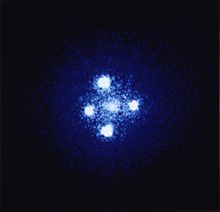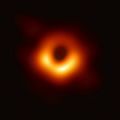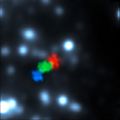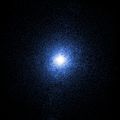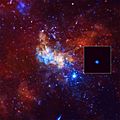Black hole facts for kids
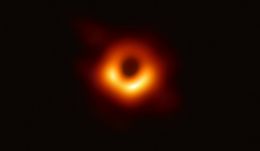
A black hole is a region of space from which nothing can escape, according to the general theory of relativity, it is the result of the curving of spacetime caused by a huge mass. Around a black hole there is a position of no return, called the event horizon. It is called "black" because it absorbs all the light that hits it, reflecting nothing, just like a perfect black body in thermodynamics.
Under the theory of quantum mechanics black holes have a temperature and emit Hawking radiation, which makes them slowly get smaller.
A black hole is found by its interaction with matter. The presence of a black hole can be inferred by tracking the movement of a group of stars that orbit a region in space. Alternatively, when gas falls into a black hole caused by a companion star or nebula, the gas spirals inward, heating to very high temperatures and emitting large amounts of radiation. This radiation can be detected from earthbound and Earth-orbiting telescopes.
Astronomers have also found evidence of supermassive black holes at the center of almost all galaxies. After observing the motion of nearby stars for 16 years, in 2008 astronomers found compelling evidence that a supermassive black hole of more than 4 million solar masses is near the Sagittarius A* region in the center of the Milky Way galaxy. Inside a black hole the rules of physics are very different.

Contents
History
In 1783, an English clergyman called John Michell wrote that it might be possible for something to be so heavy you would have to go at the speed of light to get away from its gravity. Gravity gets stronger as something gets bigger or more massive. For a small thing, like a rocket, to escape from a larger thing, like Earth, it has to escape the pull of our gravity or it will fall back. The speed that it must travel upward to get away from Earth's gravity is called escape velocity. Bigger planets (like Jupiter) and stars have more mass, and have stronger gravity than Earth. Therefore, the escape velocity is much faster. John Michell thought it was possible for something to be so big that the escape velocity would be faster than the speed of light, so even light could not escape. In 1796, Pierre-Simon Laplace promoted the same idea in the first and second editions of his book Exposition du système du Monde (it was removed from later editions).
Some scientists thought Michell might be right, but others thought that light had no mass and would not be pulled by gravity. His theory was forgotten.
In 1916 Albert Einstein wrote an explanation of gravity called general relativity.
- Mass causes space (and spacetime) to bend, or curve. Moving things "fall along" or follow the curves in space. This is what we call gravity.
- Light always travels at the same speed, and is affected by gravity. If it seems to change speed, it is really traveling along a curve in spacetime.
A few months later, while serving in World War I, the German physicist Karl Schwarzschild used Einstein's equations to show that a black hole could exist. In 1930, Subrahmanyan Chandrasekhar predicted that stars heavier than the sun could collapse when they ran out of hydrogen or other nuclear fuels to burn. In 1939, Robert Oppenheimer and H. Snyder calculated that a star would have to be at least three times as massive as the Sun to form a black hole. In 1967, John Wheeler invented the name "black hole" for the first time. Before that, they were called "dark stars".
In 1970, Stephen Hawking and Roger Penrose showed that black holes must exist. Although the black holes are invisible (they cannot be seen), some of the matter that is falling into them is very bright.
As of spring 2019, there is an image of a black hole, rather, the things orbiting the black hole, that was produced by a large team. The image require many photos from many different locations. One of the members being Katie Bouman who made the compilation of all the images into one singular image possible with her computer science background. She claims minimal knowledge of the subject matter prior her involvement in the team and she is now a prominent figure in the progression of understanding black holes.
Formation of black holes
Gravitational collapse
The gravitational collapse of huge (high-mass) stars cause "stellar mass" black holes. Star formation in the early universe may have resulted in very massive stars, which on collapse would produce black holes of up to 103 solar masses. These black holes may be the seeds of the supermassive black holes found in the centers of most galaxies.
Most of the energy released in gravitational collapse is emitted very quickly. A distant observer sees the infalling material slow and halt just above the event horizon, due to gravitational time dilation. The light emitted just before the event horizon is delayed an infinite amount of time. So the observer never sees the formation of the event horizon. Instead, the collapsing material seems to become dimmer and increasingly red-shifted, eventually fading away.
Supermassive black holes
Black holes have also been found in the middle of almost every galaxy in the known universe. These are called supermassive black holes (SBH), and are the biggest black holes of all. They formed when the Universe was very young, and also helped to form all the galaxies.
Quasars are believed to be powered by gravity collecting material into SBHs in the centers of distant galaxies. Light cannot escape the SBHs at the center of quasars, so the escaping energy is made outside the event horizon by gravitational stresses and immense friction on the incoming material.
Huge central masses (106 to 109 solar masses) have been measured in quasars. Several dozen nearby large galaxies, with no sign of a quasar nucleus, contain a similar central black hole in their nuclei. Therefore, it is thought that all large galaxies have one, but only a small fraction are active (with enough accretion to power radiation) and so are seen as quasars.
Effect on light
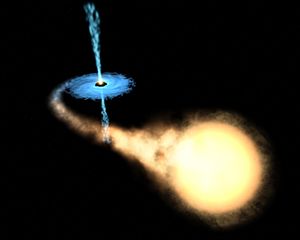
At the middle of a black hole, there is a gravitational center called a singularity. It is impossible to see into it because the gravity prevents any light escaping. Around the tiny singularity, there is a large area where light which would normally pass by gets sucked in as well. The edge of this area is called the event horizon. The area beyond the event horizon is the black hole. The gravity of the black hole gets weaker at a distance. The event horizon is the place farthest away from the middle where the gravity is still strong enough to trap light.
Outside the event horizon, light and matter will still be pulled toward the black hole. If a black hole is surrounded by matter, the matter will form an "accretion disk" (accretion means "gathering") around the black hole. An accretion disk looks something like the rings of Saturn. As it gets sucked in, the matter gets very hot and shoots x-ray radiation into space. Think of this as the water spinning around the hole before it falls in.
Most black holes are too far away for us to see the accretion disk and jet. The only way to know a black hole is there is by seeing how stars, gas and light behave around it. With a black hole nearby, even objects as big as a star move in a different way, usually faster than they would if the black hole was not there.
Since we cannot see black holes, they must be detected by other means. When a black hole passes between us and a source of light, the light bends around the black hole creating a mirror image. That effect is called gravitational lensing.
Hawking radiation
Hawking radiation is black body radiation which is emitted by black hole, due to quantum effects near the event horizon. It is named after the physicist Stephen Hawking, who provided a theoretical argument for its existence in 1974.
Hawking radiation reduces the mass and the energy of the black hole and is therefore also known as black hole evaporation. This happens because of the virtual particle-antiparticle pairs. Due to quantum fluctuations, this is when one of the particles falls in and the other gets away with the energy/mass. Because of this, black holes that lose more mass than they gain through other means are expected to shrink and ultimately vanish. Micro black holes (MBHs) are predicted to be larger net emitters of radiation than larger black holes and should shrink and dissipate faster.
Related pages
Images for kids
-
Direct image of a supermassive black hole at the core of Messier 87
-
Animated simulation of a Schwarzschild black hole with a galaxy passing behind. Around the time of alignment, extreme gravitational lensing of the galaxy is observed.
-
Simulated view of a black hole in front of the Large Magellanic Cloud. Note the gravitational lensing effect, which produces two enlarged but highly distorted views of the Cloud. Across the top, the Milky Way disk appears distorted into an arc. Published in 2019.
-
Gas cloud being ripped apart by black hole at the centre of the Milky Way (observations from 2006, 2010 and 2013 are shown in blue, green and red, respectively).
-
Predicted appearance of a non-rotating black hole with toroidal ring of ionised matter, such as has been proposed as a model for Sagittarius A*. The asymmetry is due to the Doppler effect resulting from the enormous orbital speed needed for centrifugal balance of the powerful gravitational attraction of the hole.
-
Blurring of X-rays near black hole (NuSTAR; 12 August 2014)
-
A Chandra X-Ray Observatory image of Cygnus X-1, which was the first strong black hole candidate discovered
See also
 In Spanish: Agujero negro para niños
In Spanish: Agujero negro para niños


